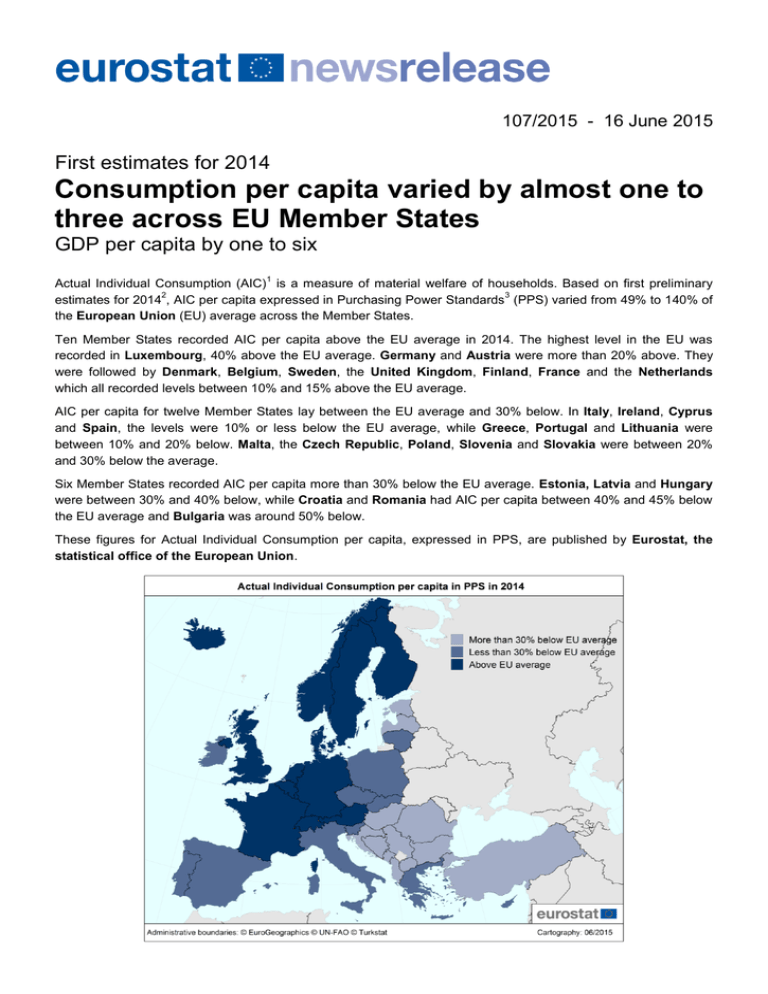News Release 107/2015 of
advertisement

107/2015 - 16 June 2015 First estimates for 2014 Consumption per capita varied by almost one to three across EU Member States GDP per capita by one to six 1 Actual Individual Consumption (AIC) is a measure of material welfare of households. Based on first preliminary 2 3 estimates for 2014 , AIC per capita expressed in Purchasing Power Standards (PPS) varied from 49% to 140% of the European Union (EU) average across the Member States. Ten Member States recorded AIC per capita above the EU average in 2014. The highest level in the EU was recorded in Luxembourg, 40% above the EU average. Germany and Austria were more than 20% above. They were followed by Denmark, Belgium, Sweden, the United Kingdom, Finland, France and the Netherlands which all recorded levels between 10% and 15% above the EU average. AIC per capita for twelve Member States lay between the EU average and 30% below. In Italy, Ireland, Cyprus and Spain, the levels were 10% or less below the EU average, while Greece, Portugal and Lithuania were between 10% and 20% below. Malta, the Czech Republic, Poland, Slovenia and Slovakia were between 20% and 30% below the average. Six Member States recorded AIC per capita more than 30% below the EU average. Estonia, Latvia and Hungary were between 30% and 40% below, while Croatia and Romania had AIC per capita between 40% and 45% below the EU average and Bulgaria was around 50% below. These figures for Actual Individual Consumption per capita, expressed in PPS, are published by Eurostat, the statistical office of the European Union. GDP per capita ranged from 45% to 263% of the EU average Gross Domestic Product (GDP) per capita, a measure of economic activity, also shows substantial differences between the EU Member States. In 2014, GDP per capita expressed in PPS ranged between 45% of the EU 4 average in Bulgaria to 263% in Luxembourg . Eleven Member States recorded a level of GDP per capita above the EU average in 2014. Actual Individual Consumption (AIC) and GDP per capita in PPS in 2014, EU = 100 AIC per capita GDP per capita 100 100 106 107 140 263 Germany 123 124 Austria 121 128 Denmark 115 124 Belgium 114 119 Sweden 114 124 United Kingdom 114 108 Finland 113 110 France 112 107 Netherlands 112 130 EU Euro area 5 Luxembourg 6 Italy 98 97 Ireland 93 132 Cyprus 91 85 Spain 90 93 Greece 83 72 Portugal 83 78 Lithuania 80 74 Malta 78 85 Czech Republic 75 84 Poland 74 68 Slovenia 74 83 Slovakia 74 76 Estonia 65 73 Latvia 65 64 Hungary 62 68 Croatia 59 59 Romania 55 54 Bulgaria 49 45 136 179 129 161 118 121 57 53 49 39 44 35 40 36 34 29 37 28 Norway Switzerland 6 Iceland Turkey* 6 Montenegro * Serbia Former Yugoslav Rep. of Macedonia Albania 6 Bosnia and Herzegovina* 6 Countries with the same value of AIC per capita are ranked by protocol order. * Based on ESA 95. 1. Actual Individual Consumption consists of goods and services actually consumed by individuals, irrespective of whether these goods and services are purchased and paid for by households, by government, or by non-profit organisations. In international volume comparisons of consumption, AIC is often seen as the preferable measure, since it is not influenced by the fact that the organisation of certain important services consumed by households, like health and education services, differs a lot across countries. 2. The figures are based on GDP and population data for 2014, extracted on 1 June 2015, and the most recent PPPs available. Revised estimates will be published in December 2015. 3. The Purchasing Power Standard (PPS) is an artificial currency unit that eliminates price level differences between countries. Thus one PPS buys the same volume of goods and services in all countries. This unit allows meaningful volume comparisons of economic indicators across countries. Aggregates expressed in PPS are derived by dividing aggregates in current prices and national currency by the respective Purchasing Power Parity (PPP). The level of uncertainty associated with the basic price and national accounts data, and the methods used for compiling PPPs imply that differences between countries that have indices within a close range should not be over-interpreted. For further information, see the Statistics Explained article on the Eurostat website: http://ec.europa.eu/eurostat/statistics-explained/index.php/GDP_per_capita,_consumption_per_capita_and_price_level_indices 4. The high GDP per capita in Luxembourg is partly due to the country's large share of cross-border workers in total employment. While contributing to GDP, these workers are not taken into consideration as part of the resident population which is used to calculate GDP per capita. 5. The euro area (EA19) consists of Belgium, Germany, Estonia, Ireland, Greece, Spain, France, Italy, Cyprus, Latvia, Lithuania, Luxembourg, Malta, the Netherlands, Austria, Portugal, Slovenia, Slovakia and Finland. The European Union (EU) includes Belgium, Bulgaria, the Czech Republic, Denmark, Germany, Estonia, Ireland, Greece, Spain, France, Croatia, Italy, Cyprus, Latvia, Lithuania, Luxembourg, Hungary, Malta, the Netherlands, Austria, Poland, Portugal, Romania, Slovenia, Slovakia, Finland, Sweden and the United Kingdom. 6. GDP and AIC data for Luxembourg, Switzerland, Montenegro, the former Yugoslav Republic of Macedonia and Albania are provisional. Issued by: Eurostat Press Office Production of data: Vincent BOURGEAIS Tel: +352-4301-33 444 eurostat-pressoffice@ec.europa.eu Paul KONIJN Tel: +352-4301-33 438 paulus.konijn@ec.europa.eu ec.europa.eu/eurostat @EU_Eurostat Media requests: Eurostat media support / Tel: +352-4301-33 408 / eurostat-mediasupport@ec.europa.eu




